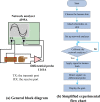Study of channel characteristics for galvanic-type intra-body communication based on a transfer function from a quasi-static field model
- PMID: 23443387
- PMCID: PMC3571791
- DOI: 10.3390/s121216433
Study of channel characteristics for galvanic-type intra-body communication based on a transfer function from a quasi-static field model
Abstract
Intra-Body Communication (IBC), which modulates ionic currents over the human body as the communication medium, offers a low power and reliable signal transmission method for information exchange across the body. This paper first briefly reviews the quasi-static electromagnetic (EM) field modeling for a galvanic-type IBC human limb operating below 1 MHz and obtains the corresponding transfer function with correction factor using minimum mean square error (MMSE) technique. Then, the IBC channel characteristics are studied through the comparison between theoretical calculations via this transfer function and experimental measurements in both frequency domain and time domain. High pass characteristics are obtained in the channel gain analysis versus different transmission distances. In addition, harmonic distortions are analyzed in both baseband and passband transmissions for square input waves. The experimental results are consistent with the calculation results from the transfer function with correction factor. Furthermore, we also explore both theoretical and simulation results for the bit-error-rate (BER) performance of several common modulation schemes in the IBC system with a carrier frequency of 500 kHz. It is found that the theoretical results are in good agreement with the simulation results.
Figures









References
-
- Taranovich S. Medical sensors encompass biomedical electronics. EDN. 2011;56:35–42.
-
- Li H.B., Kohno R. Body area network and its standardization at IEEE 802.15. BAN. In: István F., Janos B., Péter B., editors. Advances in Mobile and Wireless Communications. Springer-Verlag; Berlin/Heidelberg, Germany: 2008. pp. 223–238.
-
- Lucev Z., Krois I., Cifrek M. Intrabody communication in biotelemetry. In: Lay-Ekuakille A., Mukhopadhyay S.C., editors. Wearable and Autonomous Biomedical Devices and Systems for Smart Environment: Issues and Characterization. Springer-Verlag; Berlin/Heidelberg, Germany: 2010. pp. 351–368.
-
- Lay-Ekuakille A., Vendramin G., Trotta A., Mazzotta G. Thermoelectric generator design based on power from body heat for biomedical autonomous devices. Proceedings of 2009 IEEE International Workshop on Medical Measurements and Applications; Cetraro, Italy. 29–30 May 2009; pp. 1–4.
Publication types
MeSH terms
LinkOut - more resources
Full Text Sources

